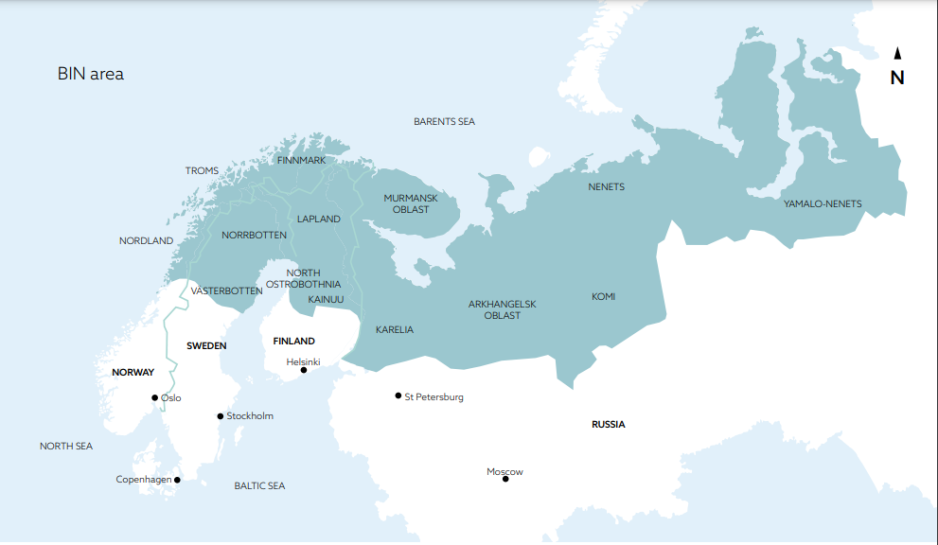Business Index North New Report Shows Negative Population Development in the North
Researcher at the High North Center Andrey Mineev and Assistant Professor Erlend Bullvåg at Nord University Business School present Business Index North at the High North Dialogue conference. (Photo: Trine Jonassen)
And it is the young, educated women who leave, the latest Business Index North report shows. “An alarming development”, says the researchers behind the report.
Despite an abundance of natural resources and a positive economic growth in most of the BIN area (see map below), the most important resource of them all and the very condition for further development is lacking – inhabitants.
That is evident in the latest findings of the Business Index North (BIN) report, which is published by the High North Center and the Nord University Business School.
“The North is losing people and with that, we lose the knowledge and skills these people possess”, says BIN Project Manager Erlend Bullvåg.

The total population in the area covered by Business Index North is some 5.5 million, 70 percent of whom live on the Russian side of the border and 30 percent on the Nordic side. Major industries in the BIN area include mining, production, construction, transport, as well as wholesale and detail sales. In addition, there are companies in fisheries and aquaculture represented in Northern Norway and also Murmansk oblast in Russia. (Source: BIN)
International interests
The increasing international interest in the High North is largely related to natural resources such as the sea, renewable energy, minerals, and tourism. However, there is also international interest related to infrastructure, transport, and also for search and rescue and geopolitical issues.
However, the number of people who live and work in the North is dropping. Arctic demography is directly related to societal and economic development. And now, the figures are moving in a dangerous security policy direction, the BIN report shows.
And it is the young – in particular women – who leave. This means that the number of working inhabitants drops and the average age in the Arctic increases. The further north one gets, the more explicit this trend is.
Education gap
The education gap between men and women increases too, and women have the highest education.
The researchers behind the report say the negative demographic development is considered the most alarming challenge related to a resilient Arctic.
We see a huge knowledge gap and we don’t have enough people to fill it.
Norway has the most densely populate areas in the Arctic and the region can refer to strong resilience when it comes to stable business and industry, as well as good health amongst its citizens.
“However, Northern Norway scores low when it comes to transition and innovation capacity”, Project Manager Erlend Bullvåg says.
Learn from Sweden
This is something Northern Sweden has succeeded with and that the rest of the High North can learn from.
“Northern Sweden is great at creating jobs in existing companies, and Oulu in Finland is best when it comes to transition”, Bullvåg says.
Nevertheless, the report demonstrates that the region as a whole performs too portly when it comes to sustainability and resilience.
20,000 people short
“We see a huge knowledge gap and we do not have the people to cover it”, the project manager says.
In fact, the North is lacking some 20,000 people to cover the knowledge gap.
In addition, the population is ageing, which makes it harder to cover the need for workers.
“The average age is 50 years, and that is a lot. We have not been able to attract the young people”, Bullvåg says.
Rural areas and cities
It also has to do with increased tension between cities and more rural areas, where the cities grow and develop while the rural areas see a decline.
“It will take a national effort to change this. The cities must take responsibility for the service industry and the rural areas must take the responsibility for industry. And there should be investments in research because there is hardly any research at all on societal development in the High North”, Bullvåg says.
“We know about the climate, but not much about people”, Bullvåg says.
“The fact that fewer and fewer people of working age live in Northern Norway is a major challenge. The most important reason for this being so is a lacking development of jobs that require high competence, both in business and society.”
The researchers argue that the following measures must be taken in order to change the negative development.
- The region must be made attractive for young people so that they both want to stay on or to come in search of an education or finding interesting jobs and then settling down. This also applies increasingly to people from foreign countries.
- A development must be created in which more of the values created in the region remain in the region. The region should be more knowledge-driven, just like the rest of the country.
- More knowledge about, for and in the High North should be developed.
- Increase the region’s capacity to transform through a far stronger focus on innovation and entrepreneurship
- At least triple the number of people working with research and development in both the private as well as the public sector, compared to the current level.
- Close the 20,000 competence job gap in the service industry in the region.
- Strengthen the cities as engines for regional development. This may lead to surrounding areas also experiencing increased population figures, such as in Northern Sweden, as well as in the Oulu and Rovaniemi regions in Finland.
- Increasingly centralize jobs in the service industry to the cities, while the developing of green and blue industry should be located where the natural resources are.
If measures are not introduced, the researchers argue, the High North will not be able to face the challenges mentioned above with the Green Shift, knowledge-based services, and an ageing and dwindling population.
“The challenges lie in the low level of innovation. It is hard to develop new industries when we do not have enough people who can work with advanced services”, BIN researcher Andrey Mineev says.
In the time ahead, it will be important to increase the attractivity of the region to young people, and in particular those with high education. Not only for those who already live there, but also for young people from other parts of the world.
Foreign Minister Anniken Huitfeldt (Labor) spoke to the High North Dialogue conference in Bodø in April 2022. (Photo: Trine Jonassen)
New models must also be made to create and coordinate interest centers, both within and outside the region, to also involve those who have been left out of the process, in particular the young.
During her speech at High North News, Norwegian Foreign Minister Anniken Huitfeldt (Labor) confirmed that the High North is high on the government’s list.
“We must make sure Northern Norway is resilient and ready to face challenges. For that, we need people, education institutions, innovation, investments, and green technology”, the foreign minister said.
Business Index North
Business Index North (BIN) is a project contributing to sustainable development and wealth creation in the Arctic. The goal is to establish a repetitive knowledge-based information tool for stakeholders such as companies, academia, the media and national as well as regional authorities.
In relation to the High North Dialogue conference taking place in Bodø on 6-7 April 2022, BIN has produced a special report about what it will take to build a stronger Northern Norway. The report shows that this requires a new kind of development initiative in a scale currently not existing.
Also read
This article was originally published in Norwegian and has been translated by HNN's Elisabeth Bergquist.



